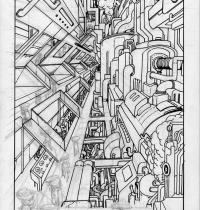George Mathen
Grant Period: Over one year and six months
George Mathen, better known by his pseudonym, “Appupen”, has already published three books and is widely regarded as a very distinct voice in the graphic novel scene in India today. After completing his Diploma in 3D Animation and Graphic Design from Xavier’s Institute of Communication, George worked as a tattoo and mural artist in Mumbai for some time before moving to the advertising industry. He then shifted to Bangalore and started working on his first graphic novel. He also founded the Bangalore based band Lounge Piranha and played drums for them. In his first graphic novel, Moonward, Appupen started building the imaginary world of Halahala, which he continued to develop in his second book, Legends of Halahala. His third book, Aspyrus, has explored yet another side of the Halahala universe. His work has been regularly featured in various magazines like Tehelka, Rolling Stone India, Time Out, Elle, Indian Quarterly, Mid-Day and Animation Reporter and various anthologies on sequential graphic art. His work has also been shown in Kochi-Muziris Biennale, 2014, Gallery SKE and Gallery 545, Bangalore.
In his next project, tentatively titled White City, George wishes to explore a futuristic realm of the Halahala universe - the city and the consumerist dreams it embodies. White City stands for the perfect marriage between religion, politics and big business, enclosed in a glass dome. Red-skinned people from the few surviving settlements outside the city-system - the last remnants of natural life - aspire to find their place in the great city and make it big someday. White City will explore the journey of George’s protagonist – one of these red-skinned people - pursuing this path of happiness to become one of the white inhabitants of this dystopic landscape.
George is experimenting with one of the markers of the practice of graphic novels. He intends to break the idea of sequential frames in panels to tell a story, embodying single, full page composite illustrations to take the narrative forward. Sequential frames in panels usually direct the audience in specific directions of the story. Using single page structure, he will have to consolidate a lot more information in that one illustration. He is not only risking lack of communication with the reader, but also forcing the reader to stay on that one page for much longer to pay more attention to every detail. The reader may miss a clue which will be useful a few pages later for the narrative, if enough attention is not paid to every detail. One will then have to continuously go back and forth to understand the story, thereby breaking the usual unidirectional way of reading graphic novels. George is also furthering his idea of ‘silent stories’ in this book. Texts not only provide clues to stories in sequential graphic art, they also create a stylistic universe through the design of the letters. While George experimented with this ‘select’ work through five short stories in his earlier book, here he is taking a big leap by restraining from using any text in a complete graphic novel.
This project is supported under the Arts Practice programme because it is challenging various given artistic norms of graphic novels. It is trying to dispense with two salient features of graphic novels as practiced all over the world – sequential frames of the panel structure and text. He is also restraining himself from using an array of colours. Although he has used colours before in the Halahala universe, this time he is using only red, black and white to highlight the sharp contrast of the white city.
While the story poses many questions across ideas of religion, politics and consumerism in a complex web of events, he is yet to finalise the narrative that he hopes will develop as he begins work on this project. He has also proposed an exhibition of 15-20 panels in full canvases. This will encompass some artworks from the book itself, but will be curated in a manner that allows the audience to grasp the story in a much condensed form. He is also planning to make an animation film. The exhibition and the animation film will not be mere illustrations of the book but different artworks stemming out of the same concept in different media, as seen by a painter and a film maker respectively. Finally, the three sets of work will together complete the entire experience of the project and audiences will have the challenge of engaging them in tandem to understand the work. Graphic novel as a medium is at a very nascent stage in India, often shadowed by styles developed in western markets. This project is an attempt to push the development of graphic novels in India in a unique direction.


